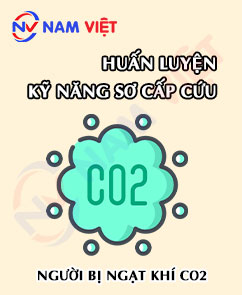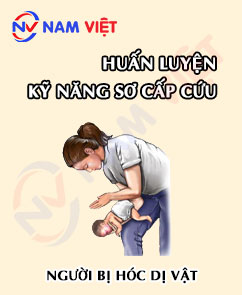First aid training for individuals suffering from carbon dioxide (CO2) asphyxiation
500,000 ₫
Note: The above price is calculated per person. Prices may vary depending on the number of participants in the course and market fluctuations. For more accurate pricing, please refer to the price list or contact our consulting staff directly.
Table of Contents
Toggle1. Identifying Carbon Dioxide (CO2) Asphyxiation Victims
a. Cases of CO2 asphyxiation
CO2 asphyxiation occurs when a person inhales carbon dioxide, causing oxygen deprivation in the body. Potential cases include:
- Turning off a car engine for an extended period while remaining inside the vehicle.
- Working in unventilated or low-oxygen spaces, especially in warehouses, containers, or areas with fuel-powered machinery, mines, wells, or tunnels.
- Being exposed to a fire or smoke-filled enclosed space.
- Using cooking appliances or fuel-powered generators in confined spaces without adequate ventilation.
- Using welding equipment or other tools in restricted areas lacking proper ventilation.
Signs of CO2 asphyxiation include headache, dizziness, fatigue, nausea, difficulty breathing, and muscle paralysis. Without prompt treatment, CO2 asphyxiation can cause serious health consequences and may be fatal.
If CO2 asphyxiation is suspected, wear a gas mask to protect yourself before attempting a rescue. If no gas mask is available, use a protective face mask to shield your nose and mouth from the toxic gas. For first aid, remove the victim from the hazardous area, ensure both your safety and the victim’s, then call emergency services and provide urgent care, including oxygen, cardiac massage, and artificial respiration, until professional rescuers arrive.

b. Signs someone is about to suffer CO2 asphyxiation
CO2 asphyxiation is a life-threatening condition. Signs include:
- Initially normal breathing, followed by faster and deeper breaths.
- Fatigue, nausea, headache, and numbness, particularly in the head region.
- Drowsiness, dizziness, and difficulty waking up.
- Visible signs such as green or gray fingertips or lips, or red patches on the skin.
- Shortness of breath, dizziness, nausea, or coughing.
If any of these signs are observed, immediate first aid measures should be taken.

c. Assessing the condition of CO2 asphyxiation victims
CO2 asphyxiation is life-threatening and can cause the following conditions:
- Oxygen deprivation: CO2 reduces oxygen levels in the blood, causing difficulty breathing, dizziness, nausea, numbness, and potentially death if untreated.
- Loss of consciousness: High CO2 levels can impair the central nervous system, causing numbness and fainting.
- Other conditions: Headache, nausea, difficulty breathing, dizziness, memory loss, irregular heartbeat, and potentially death.
Thus, upon detecting a CO2 asphyxiation victim, immediate first aid is crucial to remove them from danger.

d. Golden time for CO2 asphyxiation cases
The golden time for CO2 asphyxiation is very short and requires immediate action to preserve life and health.
Prompt rescue is critical, as delayed treatment can significantly reduce survival chances. The golden time ranges from a few minutes to several hours, depending on CO2 concentration and the victim’s condition.
Upon identifying a CO2 asphyxiation victim, authorities should be alerted immediately, and basic rescue measures should be taken to keep the victim conscious and move them out of high CO2 areas for continued treatment.
2. Overview of First Aid Training for Carbon Dioxide (CO2) Asphyxiation Victims
a. What is a first aid training course?
A first aid training course is designed to teach learners basic and advanced first aid skills. It covers lessons and practical exercises on handling emergencies such as cardiac arrest, respiratory failure, poisoning, injuries, and other urgent situations.
The course equips learners with essential skills to respond effectively to emergencies, minimize harm to themselves and others, increase survival chances, and ensure timely medical care.
REGISTER FOR BASIC FIRST AID TRAINING
b. Training duration
Initial first aid training:
- For employees: 4 hours.
- For first aid and emergency responders: 16 hours (2 days).
Periodic first aid training:
- For employees: 2 hours.
- For first aid and emergency responders: 8 hours (1 day).
c. Course content
- Basic principles of first aid and on-site emergency care
- Wound bandaging (principles, tools, techniques)
- Temporary bleeding control techniques (principles and methods)
- Temporary fracture stabilization techniques (principles and tools)
- Cardiopulmonary resuscitation (recognizing cardiac arrest, airway clearance, breathing support, CPR guidance)
- Burn management (assessing cause and severity, on-site first aid)
- Safe victim transportation with and without stretchers for initial care
- Specific emergency care scenarios:
- Electric shock
- Drowning
- Chemical accidents
- General guidance on first aid kit use
- Practical exercises for all content areas
d. First aid training certificate
Upon completing the course, learners receive a certificate confirming completion of the first aid training program under the Group 2 training framework as specified in Appendix IV, Decree 44/2016/ND-CP. The certificate is valid for 1 year.


3. Essential Tools for a First Aid Kit in Case of Carbon Dioxide (CO2) Asphyxiation
A first aid kit for CO2 asphyxiation should include the following tools:
- Rescue mask: to ensure the victim can breathe clean air and avoid exposure to toxic gas when removed from the CO2 hazard area.
- Rescue respirator: helps maintain breathing and deliver oxygen to the victim.
- Oxygen tank: provides oxygen for the victim to breathe.
- Protective gear: includes gloves, masks, protective jackets, and goggles to ensure the rescuer’s safety.
- Gas detector: to measure CO2 concentration in the environment for appropriate rescue decisions.
- Oxygen bag: used to store and deliver oxygen to the victim.
- Other rescue tools: such as flashlight, knife, scissors, gauze, pain relievers… to assist with basic rescue procedures.
Preparing a first aid kit for CO2 asphyxiation is crucial to protect the victim’s life and health during the golden time.
REGISTER FOR BASIC FIRST AID TRAINING
4. First Aid Procedure for Carbon Dioxide (CO2) Asphyxiation Victims
When discovering a CO2 asphyxiation victim, the first aid procedure includes the following steps:
- Move the victim out of the hazard area: If the victim is in a CO2 hazard area, immediately remove them to a safe location.
- Call emergency services: Upon discovering a CO2 asphyxiation victim, immediately call the emergency hotline or 115 for professional medical assistance.
- Check breathing and cardiovascular status: If the victim is unconscious, check for breathing and pulse. If absent, start CPR (cardiopulmonary resuscitation) immediately.
- Provide oxygen: If available, supply oxygen to help the victim breathe. If no oxygen machine is available, an oxygen mask or oxygen cloth can be used to facilitate breathing.
- Transport to hospital: Once rescue arrives and the victim’s condition is assessed, transport them to a hospital for further treatment. Meanwhile, continue providing oxygen to support breathing.
Note: To ensure safety for yourself and others, wear a mask and use personal protective equipment when dealing with CO2 asphyxiation victims. Ensure proper ventilation to reduce the risk of CO2 exposure.
5. Benefits of First Aid Training
First aid training provides many important benefits for individuals and the community:
- Saving lives in dangerous situations: First aid skills enable trainees to save people whose lives are at risk, such as cardiac arrest, respiratory arrest, poisoning, injuries, and other emergencies.
- Helping others learn first aid: Trained individuals can share knowledge and experience, helping the community protect itself and reduce fatalities in emergency situations.
- Reducing waiting time for rescue: When trained first aiders handle emergencies on-site, waiting time for rescue teams is minimized.
- Enhancing response and reducing stress in emergencies: First aid training equips learners to respond accurately and quickly, lowering stress and anxiety while awaiting help.
- Increasing survival rates and reducing fatalities: Timely and proper first aid improves survival chances and reduces complications or deaths in emergencies.

6. First Aid Training Capacity of An Toan Nam Viet
An Toan Nam Viet is a reputable and high-quality first aid training center in Vietnam. Training sessions are conducted continuously at workshops, factories, and construction sites nationwide (all 63 provinces of Vietnam).
REGISTER FOR BASIC FIRST AID TRAINING
Training Certification
- An Toan Nam Viet has been inspected and certified by the Department of Safety under the Ministry of Labor – Invalids and Social Affairs for occupational safety and hygiene training. Within the Group 2 training program, the first aid skills module is included, further strengthening our capacity in first aid training.

Training Materials and Lectures
- Before being used in first aid courses, training materials are reviewed to ensure accuracy and practical effectiveness.
- Instructor methods are standardized according to An Toan Nam Viet standards, developed by experts in first aid training to maximize knowledge retention for learners.
Facilities
- Controlling factors in the training room enhances teaching efficiency and knowledge absorption.
- Our training facilities provide spacious classrooms meeting standards for space, lighting, and training equipment.
7. Nationwide First Aid Training Centers
An Toan Nam Viet is one of the most reputable and professional organizations for first aid training in Vietnam. With experienced instructors, modern equipment, and high-quality programs, the center has become an ideal destination for those interested in protecting lives and health.
By attending courses at An Toan Nam Viet, you will learn basic and advanced first aid skills, from CPR for cardiac arrest, respiratory arrest, poisoning, injuries, to handling other emergency situations. The program is flexible and suitable for all learners, including adults, children, medical staff, rescue personnel, and the general public.
An Toan Nam Viet’s first aid training not only teaches essential life-saving skills but also fosters awareness to protect your own life and health as well as those around you. Training by experienced and highly qualified instructors ensures confidence and readiness for any emergency situation.
Register for first aid courses at An Toan Nam Viet to protect your life, health, and the community.
1 review for First aid training for individuals suffering from carbon dioxide (CO2) asphyxiation
No comments yet












phanminhhang341
Very good and professional first aid training unit